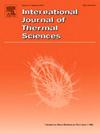浸没射流轴对称撞击旋转圆盘的传热特性
IF 4.9
2区 工程技术
Q1 ENGINEERING, MECHANICAL
International Journal of Thermal Sciences
Pub Date : 2025-05-13
DOI:10.1016/j.ijthermalsci.2025.109961
引用次数: 0
摘要
本文采用椭圆混合的雷诺应力湍流模型,对水下射流轴对称撞击旋转圆盘的传热特性进行了数值研究。基于射流雷诺数、旋转雷诺数和普朗特数的影响对传热进行了表征。研究了关键流场特征和旋转圆盘所受的阻力。使用移动网格方法捕获磁盘的刚体旋转,并与传统的移动参考系方法进行比较。研究发现,移动网格方法提供了一个关于旋转轴的更均匀的解决方案,然而,当考虑到平均传热时,移动参考系和移动网格预测之间的差异不到1%。明确区分了射流主导、过渡和旋转主导的流型。随着射流雷诺数的增大和旋转雷诺数的减小,射流主导流型在空间上沿旋转轴方向增长,旋转主导流型沿旋转轴向下游移动。确定了射流和旋转主导的传热模式,随着射流雷诺数的增加,两种模式之间的过渡点从旋转轴向外径向移动。通过对壁面剪切应力的研究,探讨了传热增强与圆盘阻力之间的权衡关系。当旋转雷诺数较高时,由于壁面剪切应力的周向分量的强烈影响,壁面剪切应力沿圆盘半径连续增加。提出了基于射流雷诺数、旋转雷诺数和普朗特数的平均换热关系式。本文章由计算机程序翻译,如有差异,请以英文原文为准。
Heat transfer characteristics of a submerged jet impinging axisymmetrically onto a rotating disk
In this paper, the heat transfer characteristics of a submerged jet impinging axisymmetrically onto a rotating disk is investigated numerically using a Reynolds stress turbulence model with elliptic blending. The heat transfer is characterized based on the effects of jet Reynolds number, rotational Reynolds number and Prandtl number. Key flow field features and the drag experienced by the rotating disk are also studied. Rigid body rotation of the disk is captured using a moving mesh approach and is compared with a traditional moving reference frame approach. It was found that the moving mesh approach provided a solution that was more uniform about the axis of rotation, however when considering the average heat transfer, there is less than a 1 % difference between moving reference frame and moving mesh predictions. A clear distinction between the jet dominated, transition and rotation dominated flow regimes is made. With increasing jet Reynolds numbers and decreasing rotational Reynolds numbers, the jet dominated flow regime spatially grows about the axis of rotation and the rotation dominated flow regime shifts downstream from the axis of rotation. Jet and rotation dominated heat transfer regimes were identified and the transition point between the two regimes shifts radially outwards from the axis of rotation as the jet Reynolds number increases. The trade-off between heat transfer enhancement and drag on the disk was explored by studying the wall shear stress. A continuous increase in the wall shear stress along the radius of the disk was observed when the rotational Reynolds number was high due to a strong influence of the circumferential component of the wall shear stress. A correlation for the average heat transfer was also proposed based on the jet Reynolds number, rotational Reynolds number and Prandtl number.
求助全文
通过发布文献求助,成功后即可免费获取论文全文。
去求助
来源期刊

International Journal of Thermal Sciences
工程技术-工程:机械
CiteScore
8.10
自引率
11.10%
发文量
531
审稿时长
55 days
期刊介绍:
The International Journal of Thermal Sciences is a journal devoted to the publication of fundamental studies on the physics of transfer processes in general, with an emphasis on thermal aspects and also applied research on various processes, energy systems and the environment. Articles are published in English and French, and are subject to peer review.
The fundamental subjects considered within the scope of the journal are:
* Heat and relevant mass transfer at all scales (nano, micro and macro) and in all types of material (heterogeneous, composites, biological,...) and fluid flow
* Forced, natural or mixed convection in reactive or non-reactive media
* Single or multi–phase fluid flow with or without phase change
* Near–and far–field radiative heat transfer
* Combined modes of heat transfer in complex systems (for example, plasmas, biological, geological,...)
* Multiscale modelling
The applied research topics include:
* Heat exchangers, heat pipes, cooling processes
* Transport phenomena taking place in industrial processes (chemical, food and agricultural, metallurgical, space and aeronautical, automobile industries)
* Nano–and micro–technology for energy, space, biosystems and devices
* Heat transport analysis in advanced systems
* Impact of energy–related processes on environment, and emerging energy systems
The study of thermophysical properties of materials and fluids, thermal measurement techniques, inverse methods, and the developments of experimental methods are within the scope of the International Journal of Thermal Sciences which also covers the modelling, and numerical methods applied to thermal transfer.
 求助内容:
求助内容: 应助结果提醒方式:
应助结果提醒方式:


